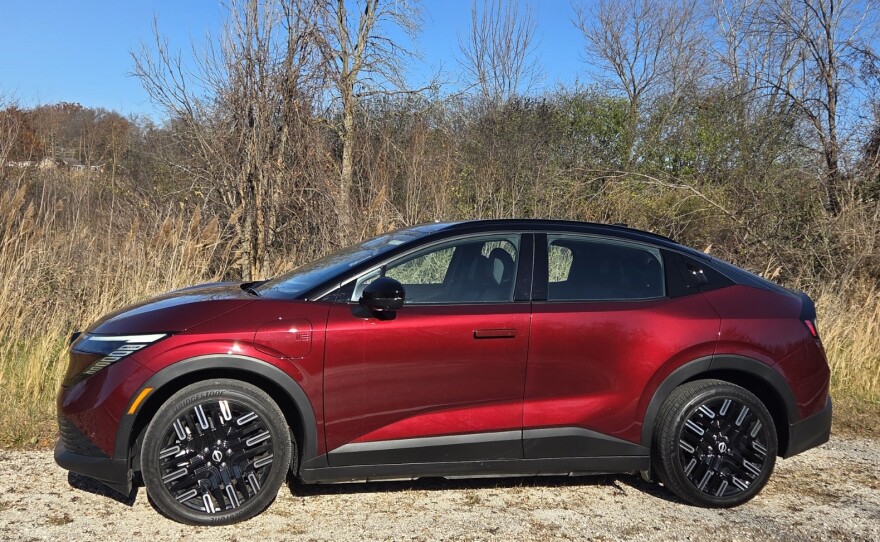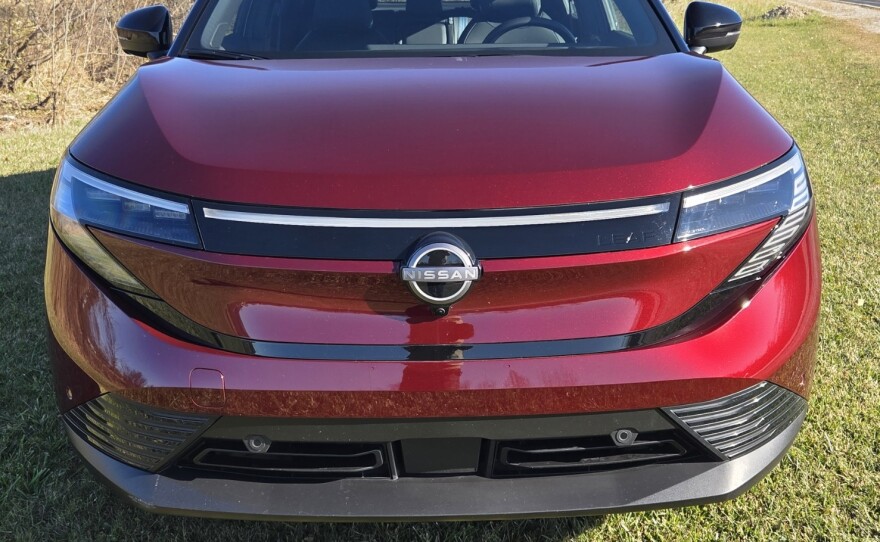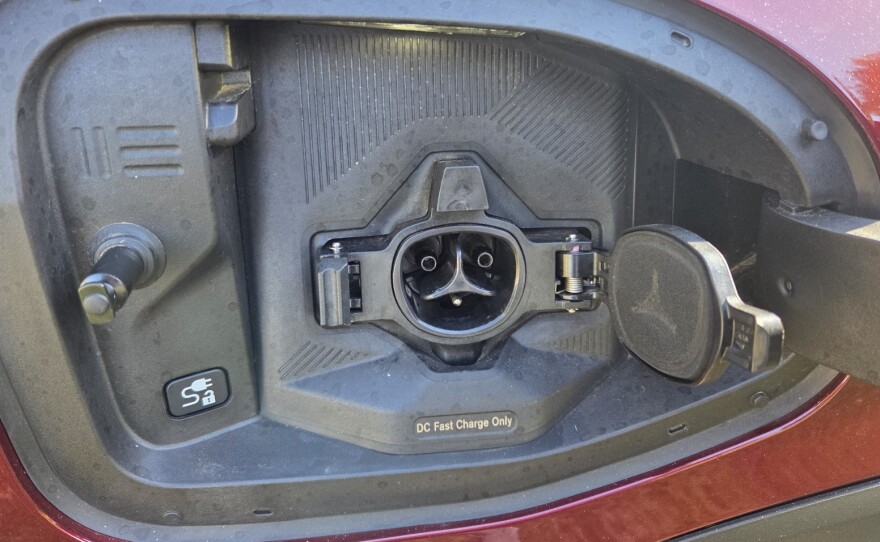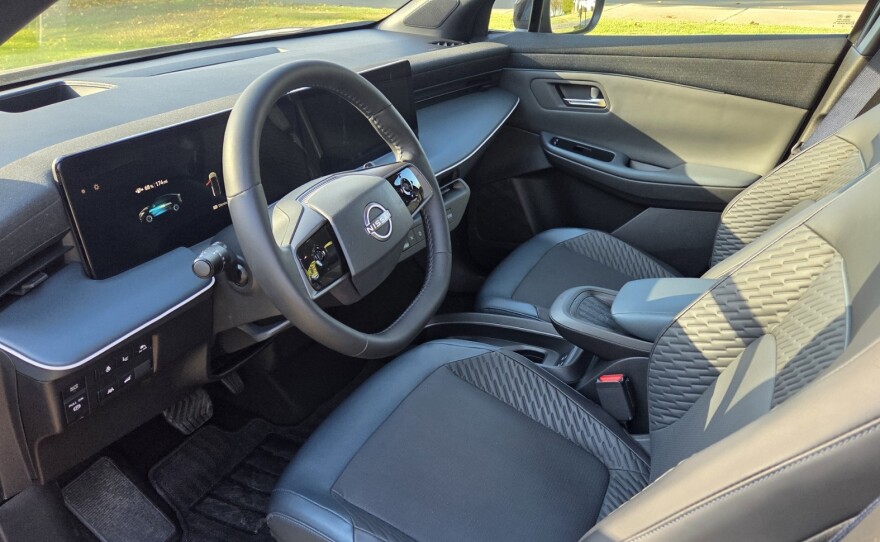Like Toyota’s Prius hybrid before it, Nissan’s all-electric Leaf has dumped its dowdy off-putting exterior in favor of something more easily sold.
Prius went super sleek and sporty, Leaf goes the handsome sedan/hatchback route that’ll help it blend in, not rub its EVness in everyone’s face. It works!
Leaf always has been the leading least expensive EV and a light, lively driver, so it’s somewhat fun while also being efficient. All that remains intact and in fact, Leaf’s range has grown substantially and charging time is down now with its 75-kwh battery pack. Range is 256 to 303 miles, depending on trim level, its lowest priced S+ model featuring the longest range. Couple that with a 10% to 80% charge at a fast charger taking just 30-35 minutes as Leaf is equipped so you can use the entire Tesla battery charging network. Bravo!
More EVs are becoming available with NACS charging. That’s what Tesla uses for plug-ins. Leaf handles this by having two nose-mounted charging ports, one on either front fender. The left charging port is for normal plugs as one has in their garage, while the right port is the NACS charger that one can use at a Tesla fast charger.
My handsome dark Coulis Red Metallic Leaf Platinum+ is the top level Leaf EV while there’s also an SV+ trim notching in above the S+ model. This Platinum+’s paint job, including a black roof, was $800 extra, and drew raves from friends and neighbors for its deep burgundy-esque coloring. A worthy splurge!But it was the overall high-quality feel and smooth, easy, responsive driving of the 2026 front-drive Leaf that got me pondering how I could put one permanently in my driveway. Power is silky in its delivery and way faster than one might imagine finding in a compact sedan with a hatch-style rear window covering a useful large cargo area. This looks like a sedan yet feels more like a compact crossover.
The Platinum+ model’s 160kW AC Synchronous Motor delivers 214 hp and a kicky 261 lb.-ft. of torque. Acceleration is fair in Eco mode, near perfect in Normal, and absolutely stunning in Sport. There’s also a Personal drive mode that an owner can adjust to meet his or her needs and driving style. Those drive modes are adjusted with a toggle at the center of the lower dash, right next to the automatic transmission buttons. Finally, a push-button system that’s easy to see and use while also being a great use of space by Nissan.
Nearby on the dash is the e-Step button that allows a driver to use mostly one pedal, the accelerator, for propelling the car or slowing it. With e-Step on, the regenerative braking uses more of the car’s braking while coasting to slow the vehicle, without the driver needing to touch the actual brake pedal. I continue likening this to what happens when one lets off the accelerator on a golf cart or the throttle on a snowmobile. The e-Step helps the Leaf slow more quickly than under normal coasting. After a couple days a driver easily learns how to smoothly use the function to constantly help replenish the batteries.
Handling here is responsive and light while feeling smooth and substantial. It’s a delicate balance that Nissan seems to have nailed on the new Leaf.
Ride has been improved, too, so Leaf handles rough Midwest roads well. No big jolts or drama here, just a solid well controlled ride as one might expect in a larger sedan.
Likewise, Leaf’s interior is quiet, both due to the electric powertrain, and sound deadening that makes this EV feel more like a mid-level sedan than an entry-level model. Like Mazda and Subaru before it, Nissan seems intent on improving its interiors’ quietness while spiffing up their look and feel. This one had a gunmetal gray fake leather interior with perforated seat cushions and soft-feel material on the doors and dash. Plus, Nissan uses a black cloth trim decorated with tiny blue dots as door top trim that wraps across the dash’s top, just above the dual digital screens for the driver’s instrument panel and info touchscreen.
All controls were easy to see and use and the screen was simple to operate while driving. Note too the Platinum+ and SV+ models feature a 14-inch info screen, up from 12.3 inches in the S+ trim. Both also have a wireless phone charging pad at the front of the console’s storage box/armrest. The Platinum+ goes a bit further adding a 10-speaker Bose sound system.
On the floor are a couple of cupholders where the console normally crowds front seat legroom. This layout creates a more open feel as those transmission buttons are all spread on the dash’s lower face. Seats are incredibly supportive and comfy for this price level with excellent lower back and hip support. The driver’s seat is powered too with power lumbar and two memory buttons while the passenger’s seat is manually adjusted. Front seats are heated as is the steering wheel, which is one of Nissan’s fine flat-bottom designs.
Other pluses include a 360-degree camera and full safety suite including emergency braking with pedestrian detection, lane departure and blind-spot warning, rear automatic braking to avoid backing out dents, and naturally a rear cross-traffic alert. Smart cruise control and lane centering are standard on the Platinum+ too.
As if one might need further incentive to consider the Leaf, well, a large opaque sunroof panel also is included and will power open. Outside there also are fancy stylish wheels to signal that Leaf is not just any ordinary small sedan.
Side note, all Leafs are currently made in Japan, so the yo-yoing tariff landscape could impact pricing at some point. No AWD models are available and no word if that feature will be coming. The test car, a pre-production model as the new Leaf is just now hitting dealerships, also added a battery heater for $300, probably smart in Wisconsin. Warm batteries lose less power and thus range in winter, plus the car’s heater seemed to start pumping warm air almost immediately when employed on a couple cold mornings. Big win for winter!
A couple other points to ponder, the rear seat is pretty roomy, so four adults can ride in Leaf, and there is oodles of cargo space behind the rear seat. Where’s the exterior rear door release? Folks were confused, but like a couple other makes, that handle is now being hidden near the top of the rear doors’ C-pillar. Easy once you locate it. Speaking of pillars, the Leaf’s A-pillar is large like so many SUVs and crossovers these days, but not a horrible sight blocker. That’s because, like Subaru, it designs some space between that pillar and the side mirrors so there’s a decent sightline between them.
Pricing?
The S+ starts at a surprisingly low $31,485 and the SV+ goes for a modest $35,725 and may be your best bet for superb EV efficiency and a well-equipped car. The tested Platinum+ lists at $40,485 with delivery and includes everything I’ve mentioned, minus the battery heater and special paint, plus $345 worth of floor mats. With all that it checked out at $41,930, about $8k below the average cost of a new vehicle, and less than most EVs.
Worried about the longevity of an EV? Well, Nissan realizes that and includes an 8-year, 100,000-mile battery warranty with a 5-year, 60,000-mile powertrain warranty.
The only competitor close on price is the Hyundai Kona EV at $35k, while most other EVs start about $41,000.
FAST STATS: 2026 Nissan Leaf Platinum+
Hits: Handsome restyled hatchback/sedan, good acceleration (power mode), easy handling, good ride, quiet interior. Reasonable charge times, flat-bottom wheel, heated seats/steering wheel, power driver’s seat, big sunroof, fancy wheels design, 360-camera, smart cruise, solid safety equipment, comfy seats, nose-mounted twin chargers, e-Pedal mode, large easy function touchscreen, and modest cost.
Misses: Not much, just large A-pillars.
Made in: Tochigi, Japan
Engine: 160kW AC Synchronous Motor, 214 hp/261 lb.-ft. torque
Transmission: Direct drive automatic
Weight: 4,367 lbs.
Wheelbase: 105.9 in.
Length: 173.4 in.
Cargo: 20-56 cu.ft.
MPGe: 110/96
Range: 256-303 mi.
Base Price: $40,485 (includes delivery)
Invoice: $38,999*
Major Options:
Floor mats, $345
Battery heater, $300
Premium 2-tone paint, $800
Test vehicle: $41,930
Sources: Nissan, www.kbb.com, *Fair Mkt. Price via kbb.com
Photos: Mark Savage





















